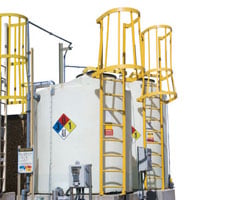Ladders for Safe Chemical Storage Systems
In some chemical storage tank applications, it is necessary to install a ladder to allow for inspection, to check gauges, and to service level sensors or mixers. But what ladder options are available, and which ones are best for the chemical you’re storing?
Available Ladder Mate
The material a ladder is made of is one of the most important factors, especially if the tank is in a containment area and there is a risk of spillover. There are different materials available to ensure chemical resistance.
 Fiberglass reinforced plastic (FRP) is a popular choice because of price and its compatibility with a number of different chemicals.
Fiberglass reinforced plastic (FRP) is a popular choice because of price and its compatibility with a number of different chemicals.- Mild steel is another popular material for ladders. They can be coated with a direct-to-metal enamel, powder coated, galvanized or epoxy coated, depending on the chemical safety requirements.
- Aluminum (a lightweight alternative) and stainless steel are also options, but they are not as popular, as they are often seen as price prohibitive.
Ladders and Safety Devices
Many ladder safety add-ons are required by OSHA depending on specific requirements. While a ladder cage might not be an OSHA requirement on one of our cross-linked polyethylene tanks unless it sits on a platform, we strive to meet the requests of all customers when it comes to safety. These ladder safety options, often requested by customers at an engineer’s recommendation, include:
- Cages - Ladders can be equipped with cages that act as safety barriers which provide fall protection. If someone falls, the cage can help catch them. Per OSHA requirements, the cages cannot extend less than 7 feet or more than 8 feet from the base of the ladder. This eliminates the possibility of someone hitting their head on the cage while walking under it.
- Fall Protection Systems - Ladders can also be equipped with a protection system that is comprised of a harness that connects to a lanyard. The lanyard is attached to a brake so that the harnessed worker can stop mid-fall. This option is not as popular as the cage, since there is maintenance involved with upkeep of the brake, lanyard and harness. This maintenance must be performed to stay in OSHA compliance. Even if OSHA does not require the protection system, if it is employed it has to meet standards.
Placement of Ladders and Other Features
OSHA requires a two-point attachment system for ladders - one at the top and one at the bottom. Poly Processing’s tanks have molded-in attachment points for bolting in ladders. The ladders are designed to attach at the manway, so that workers can climb up and inspect the inside of the tank. Polyethylene tanks are not recommended for a person walking on the dome (as plastic could give some and create a trip hazard), so it’s not usually necessary to have a ladder that reaches the very top of the tank. However, in some circumstances, personnel might need to reach gauges to read them, or they might need to reach the top of the tank to perform maintenance on level sensors or mixers. In these cases, special curved brackets will be needed to attach the ladder in the appropriate spot.
In situations where ladders are required in order to do work on the tank, they can be equipped with a 2’ x 2’ platform so that workers can stand on ladders for longer duration without balancing on the rungs.
Other Considerations in Choosing Ladders
The height of the tank is another consideration when choosing ladders. The smallest standard ladder offered by Poly Processing is 6 feet.
We can make the right ladder recommendation for your needs with information from you.
To find out if you need a ladder, and what the best option is for your chemical storage tank system, talk to a chemical storage expert.
- August 13, 2015
- Topics: Fittings and Accessories
About Poly Processing
Posts By Topic
Tech Talk Podcast Episodes
Subscribe By Email
Recent Posts
- The Best of 2025 - Top 5 Chemical Storage Blogs
- Installation Tips for Chemical Storage Tanks: Site Preparation and Offloading
- Understanding pH and Chemical Concentration When Choosing a Chemical Tank
- Maximizing Fill Efficiency: Selecting the Optimal Fill Line System
- Chemical Storage Tanks: A Quick Guide for End Users
Tank Configurator

Find the recommended tank and system components for your chemical storage challenge.
Configure a Tank Package


